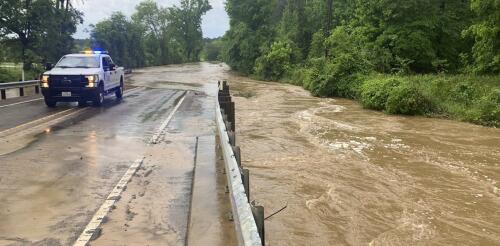Texas
In late spring, estuaries along the U.S. Gulf Coast come alive with newborn fish and other sea life. While some species have struggled to adjust to the region’s rising water temperatures in recent years, one is thriving: juvenile bull sharks. We study this iconic shark species, named for its stout body and matching disposition, along the Gulf of Mexico. Over the past two decades, we have documented a fivefold increase in baby bull sharks in Mobile Bay, Alabama, and a similar rise in several Texas estuaries, as our new study shows. Despite the bull shark’s fearsome reputation, baby bull sharks are not cause for concern for humans in these waters. While adult bull sharks are responsible for an occasional unprovoked attack, baby bull sharks haven’t fully developed the skills needed to hunt larger prey. And you’re still far more likely to be killed by bees, wasps or snakes than sharks. The fascinating life of a young bull shark Most sharks are fully marin...
Colorado has highly pathogenic avian influenza – also known as HPAI or bird flu – on a dairy farm, the ninth state with confirmed cases. The U.S. Department of Agriculture’s National Veterinary Services Laboratories confirmed the virus on April 25, 2024, in a herd in northeast Colorado. This farm is one of 35 dairy farms across the U.S. with verified cases of bird flu in cattle as of May 7, 2024, according to the USDA. Bird flu is not new to Colorado. The state experienced an outbreak in poultry that began in 2022. Since then, the USDA’s Animal and Plant Health Inspection Service has reported that 6.3 million birds in nine commercial flocks and 25 backyard flocks have been affected by the virus. The most recent detection was in February 2024. But this is the first time the disease has made cattle in Colorado sick. I’m a veterinarian and epidemiologist at Colorado State University who focuses on infectious diseases in dairy cows. I spent many years...
Scenes from the Houston area looked like the aftermath of a hurricane in early May 2024 after a series of powerful storms flooded highways and neighborhoods and sent rivers over their banks north of the city. Hundreds of people had to be rescued from homes, rooftops and cars during storms, according to The Associated Press. Huntsville registered nearly 20 inches of rain from April 29 to May 4. More storm systems over the following weeks blew out windows in Houston high rises and caused more flash flooding on urban streets and already saturated ground in the region. Floods are complex events, and they are about more than just heavy rain. Each community has its own unique geography and climate that can exacerbate flooding. On top of those risks, extreme downpours are becoming more common as global temperatures rise. I work with a center at the University of Michigan that helps communities turn climate knowledge into projects that can reduce the harm of future climate disasters. F...
Climate change is threatening America’s water infrastructure as intensifying storms deluge communities and droughts dry up freshwater supplies in regions that aren’t prepared. Severe storms that swept through the South in April 2024 illustrated some of the risks: In New Orleans, rain fell much faster as the city’s pumps could remove it. A water line broke during the storm near Hattiesburg, Mississippi. Other communities faced power outages and advisories to boil water for safety before using it. We study infrastructure resilience and sustainability and see a crisis growing, particularly in the U.S. Southeast, where aging water supply systems and stormwater infrastructure are leaving more communities at risk as weather becomes more extreme. Neighborhoods across the New Orleans area flooded on April 10 as the region’s pumps couldn’t keep up with the rainfall. Credit: Reed Timmer. To find the best solutions and b...
Strong winds spread the largest wildfire in Texas history across more than 1 million acres of rangeland in the Panhandle, the heart of the state’s cattle-producing region, and into Oklahoma in late February 2024. Light precipitation on Feb. 29 helped firefighters as they tried to contain the Smokehouse Creek Fire and other blazes threatening homes and livestock, but the heat and winds picked up again on March 2. At least two people died and scores of structures, including homes, burned. Karen Hickman, a grassland ecologist at Oklahoma State University and president of the Society for Range Management, explained why the fires spread so fast, the risks to livestock and how quickly these ecosystems can recover. How did the fires spread so far so quickly? This region of Texas and Oklahoma is mostly rangeland where cattle graze. A combination of higher-than-average temperatures and low humidity had dried out the dormant plants. When the winds picked up following a couple of ho...



